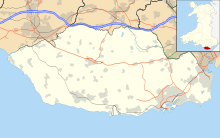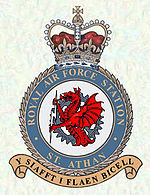- MOD St Athan
-
MoD St Athan IATA: DGX – ICAO: EGDX Summary Airport type Military Operator St Athan Location St Athan, South Wales Elevation AMSL 163 ft / 50 m Coordinates 51°24′17″N 003°26′09″W / 51.40472°N 3.43583°W Map Location in the Vale of Glamorgan Runways Direction Length Surface m ft 08/26 1,828 5,997 Asphalt MOD St Athan (IATA: DGX, ICAO: EGDX) is a large United Kingdom Ministry of Defence unit near the village of St Athan in the Vale of Glamorgan, southern Wales. It was the designated site for the United Kingdom's new defence training academy, but the programme was cancelled on 19 October 2010. It once claimed to be the largest Royal Air Force (RAF) station (though several gunnery ranges such as RAF Spadeadam are larger in area).
The base has been home to the RAF No 4 School of Technical Training throughout its life, as well as a major aircraft maintenance unit. The base has also been used to house British Army units, including the 1st Battalion, Welsh Guards. At one time it was home to a large collection of historical aircraft.
The only squadrons to operate out of St Athan on a regular basis are the University of Wales Air Squadron (one of fourteen RAF University Air Squadrons), flying Grob Tutors and No 634 Volunteer Gliding Squadron using Vigilant T.1s. 2300 Squadron of the Air Training Corps is also located on the Station.
Contents
RAF St Athan
The base officially opened as RAF St Athan on 1 September 1938 and the first unit to take up residence was No 4 School of Technical Training (4SofTT). In 1939, the station's activities were expanded with the arrival of a fighter group pool, the School of Air Navigation, and a maintenance unit. During the Second World War the station had over 14,000 personnel, and was used for training ground and air crew. It was linked to the aircraft storage and maintenance facility at RAF Llandow.
After the war, airmen of the Airframe and Engine trades continued to train at St Athan, but in 1955 this training dispersed to RAF Kirkham and RAF Weeton. 4SofTT then became a Boy Entrant School, with new recruits being trained in engine and airframe mechanics, and armament, electrical and instrument mechanics.[1] It was at this time that approval was given by the Airforce Board of the Defence Council for the formation of 2300 Sqn ATC. Following the demise of the Boy Entrant scheme in 1965, airman training returned to St Athan for the vehicle and general (non-aircraft) maintenance trades.[2]
During the 1970s, a driving school was established. Recruits that needed to drive (RAF Police, MT drivers, etc.) were trained in a fleet of Morris Minors, including 'Travellers', and were taught basic maintenance. The driving tests were normally taken in Cardiff and, once students had passed, they were then allowed to train in night and motorway driving, and practise on a skid-pan.[3]
St Athan also became the major RAF maintenance base for Vulcan, Victor, Buccaner, Phantom, Harrier, Tornado, Jaguar, Hawk and VC10 aircraft, originally under direct RAF control, but latterly under the auspices of the Defence Aviation Repair Agency (DARA). Highly specialised major servicing of the Battle of Britain Memorial Flight's Avro Lancaster bomber was also conducted at RAf St Athan.
In March 2003 it was confirmed that a new hi-tech maintenance centre would be built, creating 3,300 jobs. Additional jobs would be created by allowing access to the super-hangar by commercial aviation partners. Project Red Dragon would replace RAF St Athan's existing repair centre - spread out across the 1,000-acre (400 ha) site - and create a new, state-of-the-art facility.
In March 2004, however, DARA announced the loss of 550 jobs at St Athan as part of streamlining to make DARA more efficient and better able to compete with the private sector for lucrative aircraft repair contracts, but also because they lost out to a direct RAF bid for a contract to upgrade the air force's fleet of ageing Harrier jump jet aircraft.[4]
The MOD later decided that DARA's 'Fast Jets' and 'Engines' businesses would close by April 2007, although the 'Large Aircraft' business would continue[5] and, on 14 April 2005, the Project Red Dragon super-hangar opened and DARA moved its VC10 operations from its existing 'Twin Peaks' hangar into the new facility.
RAF ST Athan has been used to house a number of army units throughout its life and, in 2003, the 1st Battalion, Welsh Guards moved from Aldershot to St Athan - the first time they have been based in Wales since they were formed in 1915.[6]
MOD St Athan
In 2006, the Special Forces Support Group was raised at St Athan and the Welsh Guards returned to London. The station was renamed as MOD St Athan. A large swathe of land was acquired by the Welsh Assembly Government and commercial aircraft companies such as ATC Lasham started to operate from buildings such as the former VC10 hangars. DARA steadily drew down their Fast Jet and Engines operations, closing both by April 2007; the Large Aircraft business continues, but now as part of the Defence Support Group (DSG).
In 2009 building work was due to commence on a new defence training academy with its heart at St Athan. this had followed the Defence Training Review, when 3 companies tendered for two separate contracts, with the Metrix consortium being awarded the contract for package 1 (package 2 has since been withdrawn).
The training to be carried out at St Athan was to be specialist phase 2 and phase 3 engineering courses of the Royal Navy, Army and Royal Air Force. They include those courses delivered today within the Defence Colleges of Aeronautical Engineering, Electro-Mechanical Engineering and Communications and Information Systems. Phase 2 training involves initial trade training for the armed forces; phase 3 training involves continuous professional development. In addition, some training of overseas troops in the same disciplines was to be accommodated.[7]
The new academy was claimed to create up to 5000 jobs at St Athan with a £14 billion investment over 25 years with an estimated £57.4 million spent into the local economy. It was to accept its first intakes in 2012 and will be fully operational in 2017 when the last of the current training centres closes. However, changes in all these elements of the Plans were brought out by anti-Metrix campaigners, phase 3 training was deleted with reduction to a PFI total of £11 billion, the 'academy' was downgraded to a "Defence Training College", the number of jobs was halved and most disclosed as not 'created' but transferred from other MOD sites. A principal member of the Metrix consortium (the 'blue-chip' Land Securities Trillium) withdrew, to be replaced by Sodexo. A public Inquiry into compulsory purchase of land opened in January 2009 gave opportunity for local communities and Welsh organisations (Cynefin y Werin; Friends of the Earth, Cymdeithas y Cymod, Green Party) to challenge the development. The MOD and Welsh Government accepted the size was cut by more than half, but maintained their demand for the same size of estate for accommodation and support facilities. They also retained the environmentally damaging and costly approach road, though opposed strongly by local communities. Being politically sensitive, the decision on the inquiry was held up for 18 months.
The MOD continued to negotiate the project with the Metrix Consortium, but the price rose several times, reaching £14 billion in mid-2009. The decision was delayed till after the 2010 election. Then, on 19 October 2010, the DTR project was cancelled and Metrix UK lost its status as preferred bidder. On 18 July 2011, the Minister announced the RAF Lyneham base would instead be used as an integrated training centre, though consultation is awaited and the logic of the new proposal is questioned [8]. The new plans if confirmed would see expansion of the Special Forces Support Group (SFSG) on the MOD base.
Air accidents
On 26 August 1993 an ATC civilian instructor was seriously injured and the RAF Volunteer Reserve pilot was killed when their Chipmunk trainer, on an air experience flight, crashed after encountering difficulties during a simulated emergency low-height manoeuvre on take-off. The pilot attempted to recover the aircraft in a reciprocal approach however it struck the roof of the engine repair and overhaul squadron hangar and crashed to the ground at the foot of the adjacent hangar.[9]
Just before 1100 GMT on 11 February 2009, two Grob Tutor aircraft flying out of St Athan were involved in a mid-air collision in which two Air Training Corps cadets and their instructors, both RAF pilots, died. With the cause of the incident uncertain, three separate enquiries are being undertaken, including one by the Air Accidents Investigation Branch. The AAIB investigation is now completed. The report was published on 03 November 2010 and is available on their web site.[10]
The two cadet passengers were cousins and were named as Katie Jo Davies, 15, and Nikitta Walters, 14; the RAF pilots were named as Flying Officer Hylton Price and Flight Lieutenant Andrew Marsh.
Current operational units
- British Army
- RAF
- 2300 Squadron Air Training Corps
- 634 Volunteer Gliding Squadron
- University of Wales Air Squadron[11]
- MOD
- DSG
- DSG Large Aircraft
- DSG
- Defence College of Electro-Mechanical Engineering
- No 4 School of Technical Training RAF
- South and East Wales Air Support Unit
References
- ^ St Athan Magazine 1955
- ^ RAF Trade Training
- ^ Metrix Development Overview
- ^ BBC Wales News - Dara job losses
- ^ Select Committee on Welsh Affairs 22 May 2006
- ^ BBC News, Friday, 12 September, 2003, 10:46 GMT
- ^ Hansard 22 July 2008
- ^ [1]
- ^ http://aviation-safety.net/wikibase/wiki.php?id=69417
- ^ http://www.aaib.gov.uk/cms_resources.cfm?file=/6-2010%20G-BYUT%20G-BYVN.pdf
- ^ http://walesuas.co.uk
External links
- Airport information for EGDX at World Aero Data. Data current as of October 2006.
- A short history of RAF St Athan
- 634 Volunteer Gliding Squadron
Airports in Wales Aberporth · Anglesey · Caernarfon · Cardiff · Cardiff Heliport · Haverfordwest · Hawarden · Llanbedr · RAF Mona · Pembrey · MOD St Athan · Swansea · RAF Valley · Welshpool
Categories:- Vale of Glamorgan
- Royal Air Force stations in Wales
- Volunteer Gliding Squadron
- Airports in Wales
- World War II airfields
- Military training establishments of the United Kingdom
Wikimedia Foundation. 2010.


